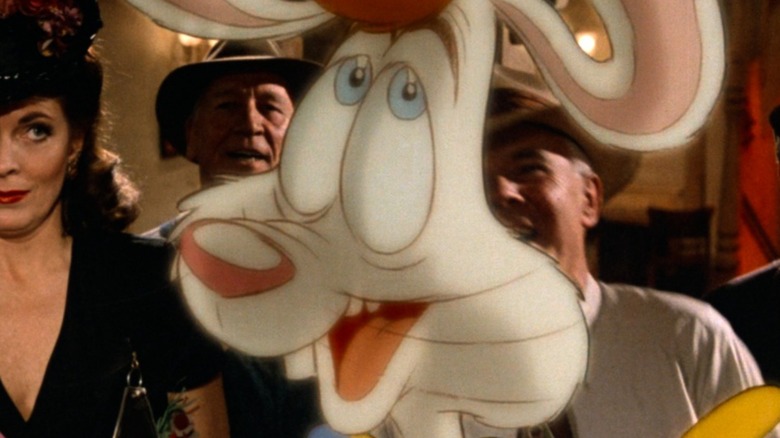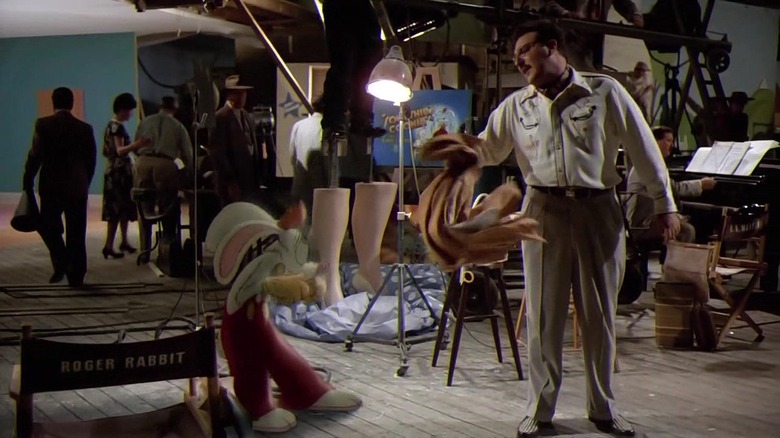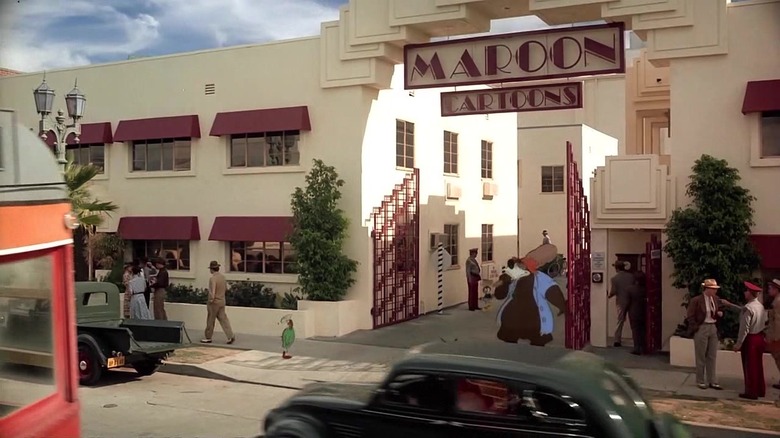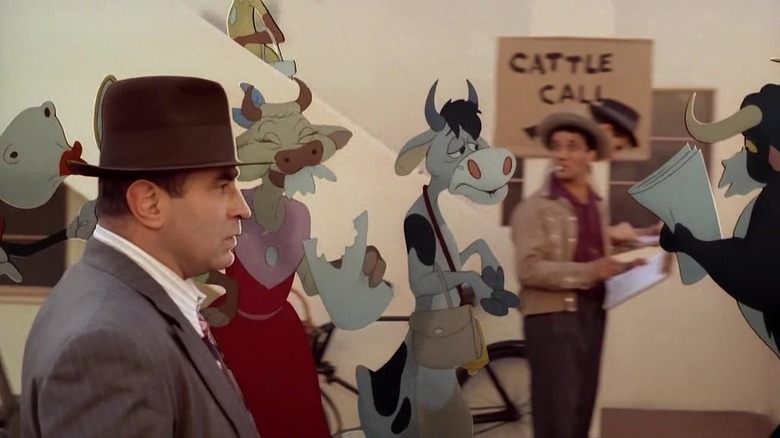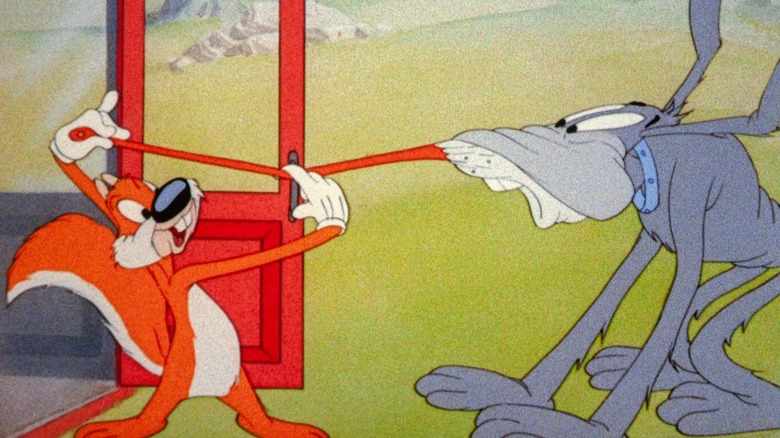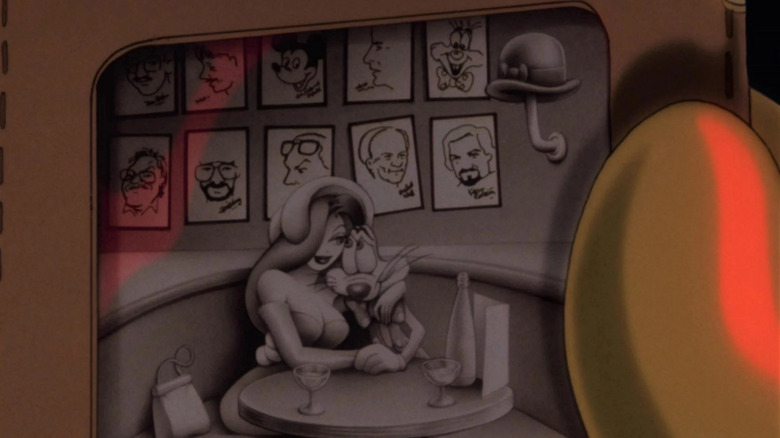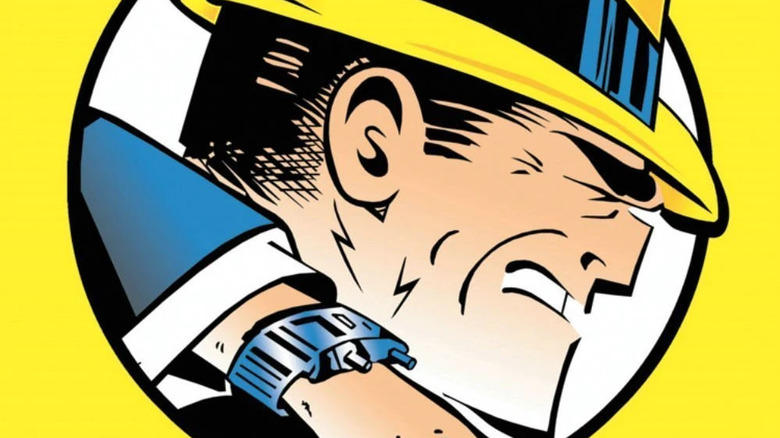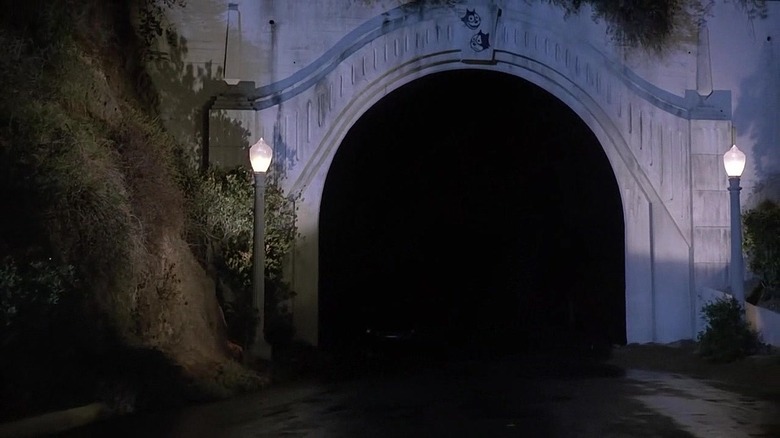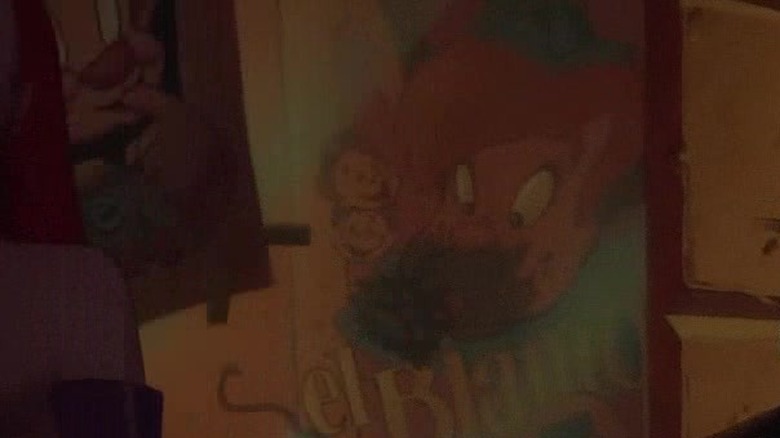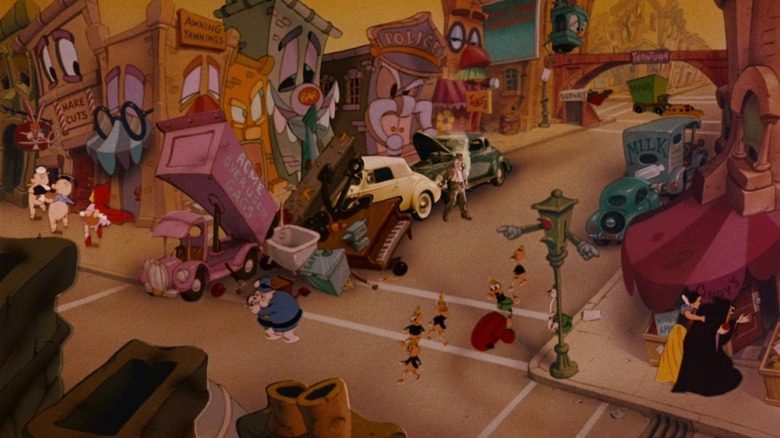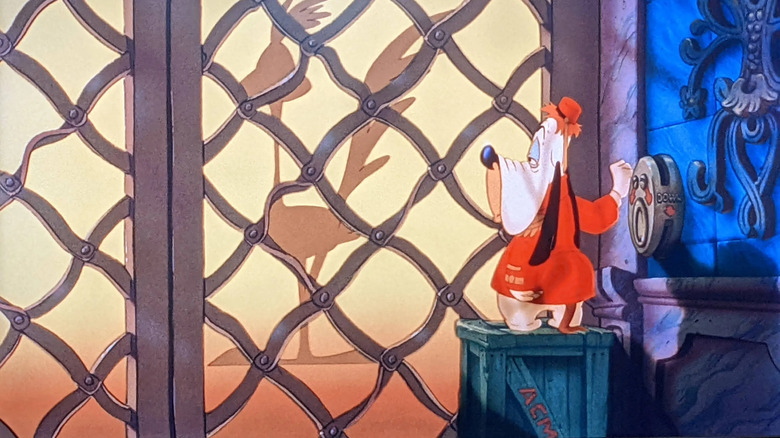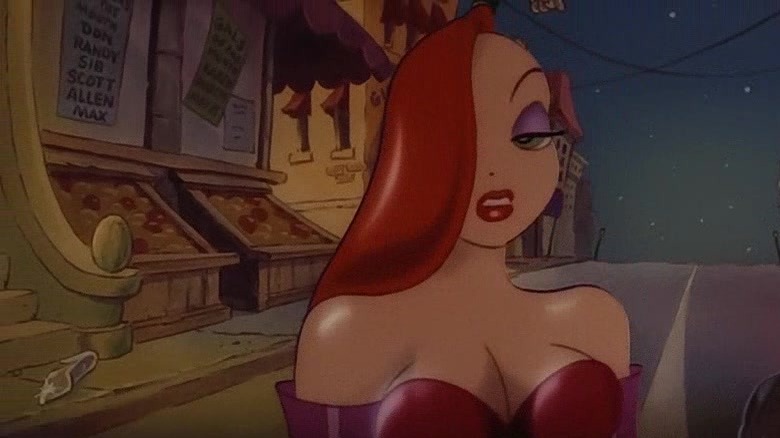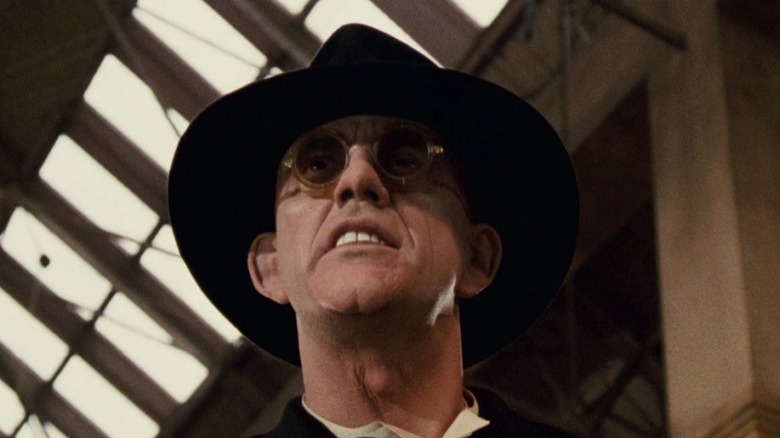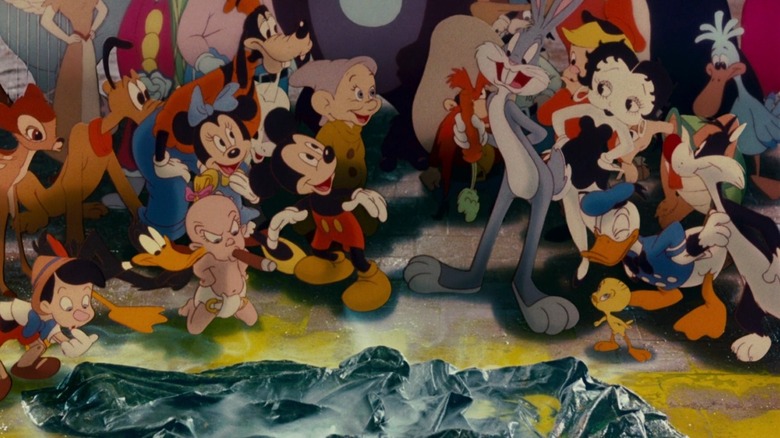Easter Eggs You Missed In Who Framed Roger Rabbit
Nowadays, Easter eggs are more prevalent than ever. Home video releases made them easier to spot, then the internet made it easier to connect with other fans to hunt them down. Major franchises like the Marvel Cinematic Universe even made them an essential tool in building hype for future installments. But before all that, "Who Framed Roger Rabbit" (or should that be "Easter rabbit?") packed every frame with more detail than a "Where's Waldo?" book. And since producer Steven Spielberg, director Robert Zemeckis, and animation director Richard Williams were all huge fans of Old Hollywood movies, live-action and animated, most of those details are packed with hidden meaning.
While modern movies include cameos and crossovers to strengthen their studios' brand, "Roger Rabbit" came by it honestly. Instead of corporations demanding their characters appear, the "Roger" crew had to engage in some intense legal wrangling to get them all onscreen. How things change.
For anyone whose memory needs refreshing, "Roger Rabbit" stars Bob Hoskins as washed-up, toon-hating detective Eddie Valiant forced back into business when a seemingly easy job leads to a string of murders and the possible destruction of Toontown itself. Zemeckis and Williams pulled out all the stops here, and it's impossible to catch all the surprises in one viewing, especially if you don't have their encyclopedic knowledge of the movies of the era. Here are our favorite Easter eggs you may have missed.
R.K. Maroon couldn't get a real toon to play Baby Herman's mother
In a nod to the classic cartoons' role as warmups for the main attraction, "Who Framed Roger Rabbit" establishes Roger, Herman, and their career together with a full "Baby Herman" short. In classic cartoon tradition, we only see Baby Herman's mother from the knees down. This might raise some questions when the director yells cut and we see Roger actually comes up to about the average human's waist.
If you're paying close enough attention, though, the movie answers that question in the same scene. As Baby Herman storms off the set, you can see an enormous pair of fake legs in the background before the dress drops like a curtain to reveal the human stuntman playing the mother. With all the parallels "Roger Rabbit" draws with the experience of real-life minorities in Hollywood, you'd think the toons would take more offense to humans stealing their roles.
The obscure and hidden cameos
The cameos start early as Eddie makes his way across the Maroon Cartoons backlot. Along with "half the cast of 'Fantasia,'" you can spot Bill the Lizard from "Alice in Wonderland" once again carrying a ladder, and a crowd including Bugs Bunny himself, the Dodo from "Porky in Wackyland," Br'er Bear from "Song of the South." It also includes Koko the Clown, who, before he became part of Betty Boop's supporting cast, pioneered the live-action/animation fusion that "Roger" took to a new level in "Out of the Inkwell."
That's already a lot to take in, and it only gets more overstuffed when Eddie enters Toontown. You can spot Jiminy Cricket in the welcome party as Eddie leaves the tunnel, along with the black lamb from one of Disney's early live-action movies, "So Dear to My Heart," as it appeared in an animated interlude. The reluctant dragon from Disney's film of the same name is practically a running gag as he keeps running from a knight. And we get some insight into the reason for the pile-up that wrecks Eddie's car with a blink-and-you-'ll-miss-it appearance from Mr. Toad, the ultimate reckless driver from Disney's "The Adventures of Ichabod and Mr. Toad."
The cattle call
The cameo parade at Maroon Cartoon Studios includes a disproportionate number of animated bulls and cows rehearsing their scripts. Some of the familiar faces include Mickey Mouse's one-time sidekick Clarabelle and the antagonist of the "Looney Tunes" classic "Bully for Bugs."
The significance of this single-species gathering might be lost on you (it certainly was on us) if you don't catch the cardboard sign or have the Hollywood insider knowledge to decode it. Or, failing that, you could just look up "cattle call" in the dictionary. Either way, you'll know that it's slang for a "mass audition," which looks to be exactly what the cattle are there for. There's even some clever logic behind the choice of cameos — as she was phased out in favor of Donald and Goofy over the course of the '30s, Clarabelle would be the toon equivalent of a desperate performer willing to take any part. And the "Looney Tunes" bull is just the opposite: His first onscreen appearance was six years after the 1947 date given in the introduction, meaning he's out looking to be discovered.
All the names Angelo throws at Eddy are real cartoons
Eddie Valiant might be a dyed-in-the-wool toon-bigot by the time we meet him, but he used to work extensively with his animated neighbors — something that other toon haters can't resist giving him a hard time about. When he stops in for a drink at the Terminal Station Bar, Angelo, another barfly lays into Eddie about his toon ties: "So who's your client, Mister Detective to the Stars? Chilly Willy? Or Screwy Squirrel? ... Someone kidnap Dinky Doodle?"
These probably sound like parodies of goofy cartoon names, but Zemeckis isn't here to goof around. They're all real pieces of animation history, as described in Leonard Maltin's "Of Mice and Magic." Chilly Willy the penguin was a star at Walter Lantz studios, the creators of Woody Woodpecker (who'll put in an appearance at the end). Some of his best cartoons were directed by Tex Avery, who took cartoons to new levels of slapstick surrealism during his brief time at Warner Bros, where he directed the first appearances of both Looney Tunes characters Bugs Bunny and Daffy Duck. Avery later found a more permanent home at MGM, where he created future elevator operator Droopy Dog. Droopy starred in over 20 cartoons; Avery's other creation, Screwy (or Screwball) Squirrel wasn't so lucky, disappearing after five.
Angelo must have a long memory to pull out Dinky Doodle. Lantz's first cartoon star and an early precursor to the live-action/animation combo of "Roger," Dinky Doodle dates all the way back to the silent era. A little boy accompanied by his dog Weakheart, Dinky costarred with Lantz himself in a series that ran for a year in 1924-1925.
Roger and Jessica at the Brown Derby
Even when Zemeckis and Williams give us a still image, you'll still probably need the pause button to catch up on all the surprises it contains. Heartbroken after seeing the pictures of Jessica Rabbit apparently cheating on him with Marvin Acme, Roger wanders into a dark alley and reminisces over the happier times recorded in his wallet photos. Based on the caricature-covered wall and derby-shaped lampshade, one of them apparently shows them at the Brown Derby, a Hollywood staple since 1926.
The upscale eatery is equally known for being a celebrity hangout and being shaped like a giant derby hat, but that's not the Easter egg. The real fun is in whose caricatures are hanging up there. You can spot some anachronistic appearances by Spielberg, Zemeckis, Williams, and other crew members, along with Mickey Mouse and Roger himself. Not content with showing the Brown Derby in their movies, Disney eventually made one of their own. A year before "Roger" premiered, Disney World added a new Disney-MGM Studios park, including a replica Brown Derby.
Roger's Dick Tracy impression
Most of the cartoon references in "Who Framed Roger Rabbit" come from animation, but that doesn't mean the movie's ignoring the toons' newsprint cousins either. Eddie and Roger spend a good chunk of the runtime literally stuck together when the rabbit pranks Eddie by hiding in the closet and slapping a pair of cuffs on him. As he announces Eddie is "under arrest," he hides under Valiant's fedora and his face turns into a solid block for a moment.
Has Roger Rabbit become Roger Robot? No, he's just using toon physics to do an impression on one of the era's biggest comics stars, the square-jawed detective Dick Tracy. Created by Chester Gould in 1931, "Dick Tracy" became a hit in large part because of its cast of cartoonishly grotesque villains like Flat-Top, Mumbles, and the Mole. Coincidentally, Disney would produce a "Dick Tracy" movie two years after "Roger" starring Madonna, Warren Beatty, and Al Pacino. Or maybe it's not a coincidence. "Dick Tracy" cinematographer Vittorio Stotaro's Sunday-funnies colors and John Caglione Jr. and Doug Drexler's note-perfect makeup for Gould's ghouls add up to a live-action cartoon that may well have been inspired by the live-action cartoon hybrid world of "Roger Rabbit."
The Felix the Cat crest
"Roger Rabbit" was an unprecedented collection of hundreds of cartoon icons interacting with each other and with flesh-and-blood actors. But not all the toons appeared in the flesh. At least one is etched in stone.
Take a close look at the Toontown tunnel, and you can spot the familiar face of Felix the Cat, created by Otto Mesmer and Pat Sullivan way back in 1919. It's a fitting tribute in a couple of ways. Town crests usually depict the founder, and you could make an argument Felix really is Toontown's first father. There had been other, smaller animated characters before him, but Maltin describes Felix as the first true superstar, easily leaving predecessors like Farmer Alfalfa and Colonel Heeza Liar in the dust.
The crest also shows two Felix faces, one laughing and the other crying. That makes it Toontown's version of the classic comedy and tragedy masks that have been the symbol of the theater for centuries — fitting for a neighborhood so heavily intertwined with show biz.
Watch for the signs
Toontown is even more Easter-egg packed than the movie's live-action neighborhoods. One warning sign for "Falling anvils" suggests the hazards of living in a town that runs on cartoon logic. You can also see the offices of the Three Little Pigs construction company above Eddie's head. Willie, the giant who tried to grind Mickey, Donald, and Goofy's bones to make his bread in "Fun and Fancy Free" appears on a theater marquee. Dopey the dwarf, Toby, the tortoise of "The Tortoise and the Hare," and Pinocchio's friend Lampwick use their stardom to act as celebrity pitchmen on ad posters. So does Porky Pig, who probably has personal reasons for endorsing a brand of all-beef sausages.
There are also some seedier goods and services being advertised: Graffiti in the floorless bathroom where Eddie takes a plunge to the sidewalk advises "For a good time, call Allison Wonderland." For example, in the back alleys, posters advertise a magic act that, based on the magician's suggestive positioning of a stretchy balloon over his crotch, is not for kids. That's to say nothing of Br'er Bear's personal services, with the slogan, "Not too hard, not too soft, just right."
The recycled animation
For all the cartoon crossovers, "Roger" was a Disney production first and foremost, and the Mouse House dug into their back catalog to fill out the crowd scenes.
The Disney vault was a perfect bridge over that gap — several scenes on Eddie's drive into Toontown seem to be traced directly from the old shorts, including the girl's-school's rabbits from "The Tortoise and the Hare," the dancing "Merry Dwarfs," and Ferdinand the Bull. And Disney didn't neglect their other projects either: The title characters from "Mickey's Orphans" run across Toontown's multicolored fields, and you can spot unicorns and cherubs from "Fantasia" and the dancing moles from "Song of the South."
The clip show continues as Eddie reaches the heart of Toontown, including a loop of the ignored traffic cop from "Tortoise," and the Three Little Pigs walking Little Red Riding Hood home from "The Big Bad Wolf," while the wolf himself peers from behind a streetlamp. You can also see some repurposed footage from "Snow White," including the princess helping the witch stagger along and the Seven Dwarfs marching into the subway instead of the mines.
The Road Runner and Wile E. Coyote silhouettes
It's easy to say these Easter eggs are so dense that if you blink, you'll miss them. But there's at least one that's impossible to catch if you blink even once.
As Eddie and Droopy are taking their trip up the elevator to the top floor where Valiant thinks he saw Jessica, they whiz by the silhouettes of other residents waiting for a lift. Pause at just the right moment, and you'll be able to see who they are: Wile E. Coyote and the Road Runner. Presumably, Wile E. would have been able to finally catch his quarry if he'd just taken the stairs. It's a little anachronistic: The duo wouldn't be "discovered" until "Fast and Furry-ous" in 1949, two years after "Roger" takes place. But there's still something fitting about showing the characters in silhouette based on how often Wile E.'s left his silhouette behind as he crashes through one obstruction or another — a gag "Roger" had already paid tribute to in an earlier scene of the title character leaving a rabbit-shaped hole in R.K. Maroon's window.
Cinderella's slipper hides in the background
Not every classic cartoon character in "Roger Rabbit" actually appears onscreen — but sometimes they leave little tokens behind for eager eyes. Take for instance the scene where Eddie finally catches up with both Jessica and Judge Doom in Toontown's dark alleys. Among all the trash littering the streets, there should be one item every Disney fan, and everyone else with a good memory for their childhood storybooks should recognize — if they manage to catch it. That would be Cinderella's legendary glass slipper. How one woman can lose the same shoe so many times is anyone's guess. We have to imagine her fairy godmother has a whole closet full of these things if Cindy goes through them this quickly. Then again, it is a slipper made of glass — anywhere but Toontown, it'd probably fall off every time she tries to make a step in it.
The foreshadowing of Judge Doom's true identity
There's not much doubt to the question of "Who Framed Roger Rabbit" when Christopher Lloyd rolls up to the scene of the Acme murder dressed all in black and carrying a skull-handled cane as Judge Doom — not exactly a name you can trust. But even if we know the killer from the start, "Roger Rabbit" still manages to pull out a shocking — and for many young viewers, traumatizing — twist. The toon-hating judge is himself a toon in human skin.
Like any good twist, there are enough subtle hints to make it all fit together when you know it's coming. Doom's creepy pallor has a distinctly waxy texture to it — almost like he was wearing a latex mask, which, of course, he is. He never takes it off, but in the climax, he pops out his fake human eyes to reveal the burning red toon eyes underneath. Just before this happens, the movie's already planting the concept of false eyes in your head: Doom trips over an upturned crate full of them and the impact seems to have jarred his own eye loose based on the way he holds it in.
Even in a world of living furniture and talking animals, the illusion isn't perfect. Watch his mouth: In some scenes, his teeth are animated, in others they're prosthetics, but they always look distinctly toony. And when Eddie seems to take a clear shot at Doom in the alleys, he walks away unscathed — remember what Lt. Santino said about how "we used to think there was no way to kill a toon?"
The ending cameo cavalcade
Cartoon cameos are all over "Roger Rabbit," but one scene in particular is so jam-packed it requires a lot of attention. When Doom's dip-spewing tractor rams a hole in the Acme warehouse, something like half the population of Toontown shows up to see what's going on.
The hole reveals Acme's warehouse is built outside the flowers and trees from the Silly Symphony "Flowers and Trees." Some of the characters we've seen before return to speculate on Doom's true identity, along with Pinocchio, Woody Woodpecker, and Disney's Big Bad Wolf (who, in a gag fast-paced enough to be an honorary Easter egg, says Doom wasn't a sheep while pulling off the proverbial sheep's clothing). The best we can do for the rest of the crowd is a partial list, with some explanations for the deeper cuts: Bambi, Goofy, Dopey, Pluto, Minnie Mouse, Sylvester and Tweety, Peter (of "Peter and the Wolf"), the singing harp from "Mickey and the Beanstalk," José Carioca of the Three Caballeros, Speedy Gonzales, Foghorn Leghorn, Sam Sheepdog, Marvin the Martian, Snow White, and Tweedle-Dee (or is it Tweedle-Dum?).
Even the police squad clearing everyone out is full of stars. Besides Porky Pig letting us know that's all, folks, there's Mickey's pal Horace Horsecollar and enemy Peg Leg Pete.
